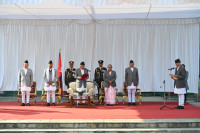National
How government backtracked on its plan to provide additional free electricity
Managing Director of Nepal Electricity Authority Kul Man Ghising says the utility sought guaranteed compensation for the cost it would have to bear.
Prithvi Man Shrestha
In its policies and programmes, the government had announced that it would provide up to 50 units of electricity free of charge in the rainy season and up to 30 units in the winter.
The promise was made as per the Common Minimum Programme (CMP) of the current ruling alliance. But the announcement met with strong reaction from the Nepal Electricity Authority (NEA), which does not charge any tariff on households that consume less than 20 units a month with five-ampere metres.
Such households, however, have to pay a minimum service charge of Rs30 per month. “We asked the government to first give a written guarantee that the NEA would be compensated for additional free electricity to be provided to the households,” said Kul Man Ghising, managing director of the NEA.
After the utility expressed its displeasure at the free electricity policy, the government backtracked on its announcement when it presented the budget for the fiscal year 2023-24 on May 29. Currently, the NEA itself bears the cost of providing free electricity to households that consume less than 20 unit power.
Starting in November 2021, the Electricity Regulatory Commission implemented a revised tariff plan, provisioning free electricity for households consuming less than 20 units a month.
The NEA does not want to provide additional power for free and if it is forced to do so, it wants compensation from the government as it wants to invest heavily on improving the transmission and distribution infrastructure.
During a press meet on Sunday, Ghising lamented the poor state of the country’s transmission infrastructure, which has prevented the utility from supplying adequate power in some areas despite having surplus energy in the wet season.
Ghising also complained of the limited funds made available for the building of transmission infrastructure.
According to the budget for the next fiscal year, the government has allocated Rs38.32 billion for setting up domestic transmission infrastructure and cross-border transmission lines.
For the current fiscal year, the government had allocated Rs43.95 billion for building transmission lines and substations. Ghising argued that the NEA itself could have generated a huge revenue had it not been forced to cut electricity tariff in the last three years.
“We reduced the electricity tariff by 25 percent in the last three years,” Ghising said. “Otherwise, we would have made an additional profit of Rs25 billion in these years and we would not have to seek help from others for investing in infrastructure.”
The NEA needs around Rs800 billion to build infrastructure to increase domestic consumption and boost exports. Ghising was making his position clear that it would be difficult to distribute free electricity in more quantities.
“With the budget omitting the announcement made in the policies and programmes, we need no longer implement the policy announcement,” said Manoj Silwal, chief of the distribution and consumer service directorate.
The power utility estimates that implementing the free electricity provision would cost Rs12 billion per year.
The NEA has been providing free electricity to about 2.2 million households but the number goes down to around 1.6 million in the summer when households in the Tarai consume more electricity due to heat. As of last fiscal year (2021-22), there were a total of 4.76 million consumers of electricity, including commercial and household users.
“We provide over 18 million units of electricity free of charge every month,” Silwal said. “The cost of free electricity stands at around Rs1.8 billion a year and implementing the government’s announcement in policies and programmes would cost an additional Rs10 billion annually.”




 11.12°C Kathmandu
11.12°C Kathmandu















